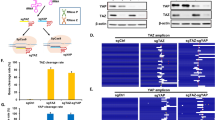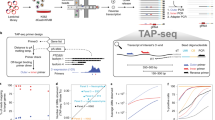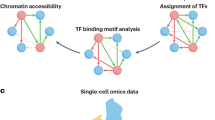Abstract
Genetic interactions influence many phenotypes and can be used as a powerful experimental tool to discover functional relationships between genes. Here we describe a robust and scalable method to systematically map genetic interactions in human cancer cells using combinatorial RNAi and high-throughput imaging. Through automated, single-cell phenotyping, we measured genetic interactions across a broad spectrum of phenotypes, including cell count, cell eccentricity and nuclear area. We mapped genetic interactions of epigenetic regulators in colon cancer cells, recovering known protein complexes. Our study also revealed the prospects and challenges of studying genetic interactions in human cells using multiparametric phenotyping.
This is a preview of subscription content, access via your institution
Access options
Subscribe to this journal
Receive 12 print issues and online access
$259.00 per year
only $21.58 per issue
Buy this article
- Purchase on Springer Link
- Instant access to full article PDF
Prices may be subject to local taxes which are calculated during checkout




Similar content being viewed by others
References
Hartman, J.L. IV., Garvik, B. & Hartwell, L. Principles for the buffering of genetic variation. Science 291, 1001–1004 (2001).
Farmer, H. et al. Targeting the DNA repair defect in BRCA mutant cells as a therapeutic strategy. Nature 434, 917–921 (2005).
Huang, S. et al. MED12 controls the response to multiple cancer drugs through regulation of TGF-β receptor signaling. Cell 151, 937–950 (2012).
Costanzo, M. et al. The genetic landscape of a cell. Science 327, 425–431 (2010).
Dixon, S.J., Costanzo, M., Baryshnikova, A., Andrews, B. & Boone, C. Systematic mapping of genetic interaction networks. Annu. Rev. Genet. 43, 601–625 (2009).
Bandyopadhyay, S. et al. Rewiring of genetic networks in response to DNA damage. Science 330, 1385–1389 (2010).
Baryshnikova, A. et al. Quantitative analysis of fitness and genetic interactions in yeast on a genome scale. Nat. Methods 7, 1017–1024 (2010).
Nichols, R.J. et al. Phenotypic landscape of a bacterial cell. Cell 144, 143–156 (2011).
Bernards, R. A missing link in genotype-directed cancer therapy. Cell 151, 465–468 (2012).
Brough, R. et al. Functional viability profiles of breast cancer. Cancer Discov. 1, 260–273 (2011).
Luo, J. et al. A genome-wide RNAi screen identifies multiple synthetic lethal interactions with the Ras oncogene. Cell 137, 835–848 (2009).
Sandmann, T. & Boutros, M. Screens, maps & networks: from genome sequences to personalized medicine. Curr. Opin. Genet. Dev. 22, 36–44 (2012).
Boutros, M. & Ahringer, J. The art and design of genetic screens: RNA interference. Nat. Rev. Genet. 9, 554–566 (2008).
Boehm, J.S. & Hahn, W.C. Towards systematic functional characterization of cancer genomes. Nat. Rev. Genet. 12, 487–498 (2011).
Houston, S.I. et al. Catalytic function of the PR-Set7 histone H4 lysine 20 monomethyltransferase is essential for mitotic entry and genomic stability. J. Biol. Chem. 283, 19478–19488 (2008).
Wu, S. et al. Dynamic regulation of the PR-Set7 histone methyltransferase is required for normal cell cycle progression. Genes Dev. 24, 2531–2542 (2010).
Casey, F.P., Cagney, G., Krogan, N.J. & Shields, D.C. Optimal stepwise experimental design for pairwise functional interaction studies. Bioinformatics 24, 2733–2739 (2008).
Horn, T. et al. Mapping of signaling networks through synthetic genetic interaction analysis by RNAi. Nat. Methods 8, 341–346 (2011).
Mani, R., St Onge, R.P., Hartman, J.L. IV., Giaever, G. & Roth, F.P. Defining genetic interaction. Proc. Natl. Acad. Sci. USA 105, 3461–3466 (2008).
Smyth, G.K. Linear models and empirical Bayes methods for assessing differential expression in microarray experiments. Stat. Appl. Genet. Mol. Biol. 3, 3 (2004).
Doyon, Y. & Cote, J. The highly conserved and multifunctional NuA4 HAT complex. Curr. Opin. Genet. Dev. 14, 147–154 (2004).
Morrison, A.J. & Shen, X. Chromatin remodelling beyond transcription: the INO80 and SWR1 complexes. Nat. Rev. Mol. Cell Biol. 10, 373–384 (2009).
Ajuh, P. et al. Functional analysis of the human CDC5L complex and identification of its components by mass spectrometry. EMBO J. 19, 6569–6581 (2000).
Rzymski, T., Grzmil, P., Meinhardt, A., Wolf, S. & Burfeind, P. PHF5A represents a bridge protein between splicing proteins and ATP-dependent helicases and is differentially expressed during mouse spermatogenesis. Cytogenet. Genome Res. 121, 232–244 (2008).
Lin, Y.Y. et al. Functional dissection of lysine deacetylases reveals that HDAC1 and p300 regulate AMPK. Nature 482, 251–255 (2012).
Marcotte, R. et al. Essential gene profiles in breast, pancreatic, and ovarian cancer cells. Cancer Discov. 2, 172–189 (2012).
Bassik, M.C. et al. A systematic mammalian genetic interaction map reveals pathways underlying ricin susceptibility. Cell 152, 909–922 (2013).
Roguev, A. et al. Quantitative genetic-interaction mapping in mammalian cells. Nat. Methods advance online publication, 10.1038/nmeth.2398 (13 February 2013).
Carpenter, A.E. et al. CellProfiler: image analysis software for identifying and quantifying cell phenotypes. Genome Biol. 7, R100 (2006).
Fuchs, F. et al. Clustering phenotype populations by genome-wide RNAi and multiparametric imaging. Mol. Syst. Biol. 6, 370 (2010).
Held, M. et al. CellCognition: time-resolved phenotype annotation in high-throughput live cell imaging. Nat. Methods 7, 747–754 (2010).
Pau, G., Fuchs, F., Sklyar, O., Boutros, M. & Huber, W. EBImage—an R package for image processing with applications to cellular phenotypes. Bioinformatics 26, 979–981 (2010).
Jones, T.R., Carpenter, A.E. & Golland, P. Voronoi-based segmentation of cells on image manifolds. Comput. Vis. Biomed. Image Appl. 535–543 (2005).
Huber, W., von Heydebreck, A., Sültmann, H., Poustka, A. & Vingron, M. Variance stabilization applied to microarray data calibration and to the quantification of differential expression. Bioinformatics 18 (suppl. 1), S96–S104 (2002).
Axelsson, E. et al. Extracting quantitative genetic interaction phenotypes from matrix combinatorial RNAi. BMC Bioinformatics 12, 342 (2011).
Benjamini, Y. & Hochberg, Y. Controlling the false discovery rate: a practical and powerful approach to multiple testing. J. R. Stat. Soc., B 57, 289–300 (1995).
Acknowledgements
We thank T. Horn, T. Sandmann and members of the Boutros and Huber groups for helpful discussions. M. Boutros is supported by a European Research Council Advanced Grant (“Syngene”). W.H. acknowledges support by the European Union project Systems Microscopy. C.L. and B.F. were supported by the CellNetworks Cluster of Excellence of the German Research Foundation (DFG).
Author information
Authors and Affiliations
Contributions
C.L., B.F., W.H. and M. Boutros designed the study; C.L. performed the experiments; B.F. analyzed the data; M. Billmann contributed to experiments; C.L., B.F., W.H. and M. Boutros wrote the manuscript.
Corresponding authors
Ethics declarations
Competing interests
The authors declare no competing financial interests.
Supplementary information
Supplementary Text and Figures
Supplementary Figures 1–6 (PDF 1325 kb)
Supplementary Table 1
Target genes (XLS 56 kb)
Supplementary Table 2
siRNA designs (XLS 149 kb)
Supplementary Table 3
qPCR primers (XLS 75 kb)
Supplementary Table 4
Screened siRNAs (XLS 68 kb)
Supplementary Table 5
Interaction scores (XLS 10537 kb)
Rights and permissions
About this article
Cite this article
Laufer, C., Fischer, B., Billmann, M. et al. Mapping genetic interactions in human cancer cells with RNAi and multiparametric phenotyping. Nat Methods 10, 427–431 (2013). https://doi.org/10.1038/nmeth.2436
Received:
Accepted:
Published:
Issue Date:
DOI: https://doi.org/10.1038/nmeth.2436
This article is cited by
-
A systematic analysis of genetic interactions and their underlying biology in childhood cancer
Communications Biology (2021)
-
Analyse von Zellfunktionen mit Hochdurchsatz-Mikroskopie und KI
BIOspektrum (2021)
-
Combined PARP and ATR inhibition potentiates genome instability and cell death in ATM-deficient cancer cells
Oncogene (2020)
-
Scanning electron microscopy and machine learning reveal heterogeneity in capsular morphotypes of the human pathogen Cryptococcus spp.
Scientific Reports (2020)
-
Design, execution, and analysis of CRISPR–Cas9-based deletions and genetic interaction networks in the fungal pathogen Candida albicans
Nature Protocols (2019)



